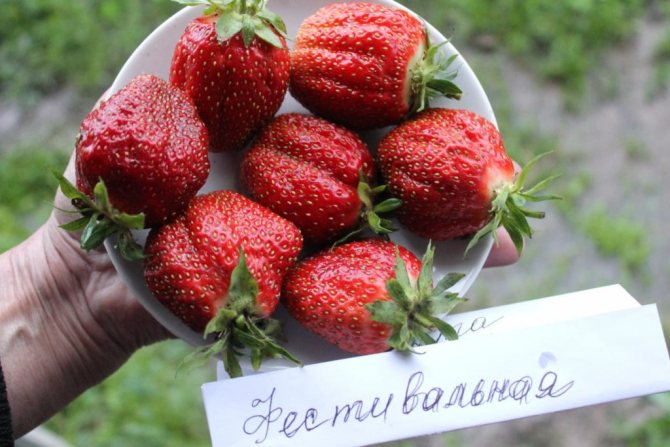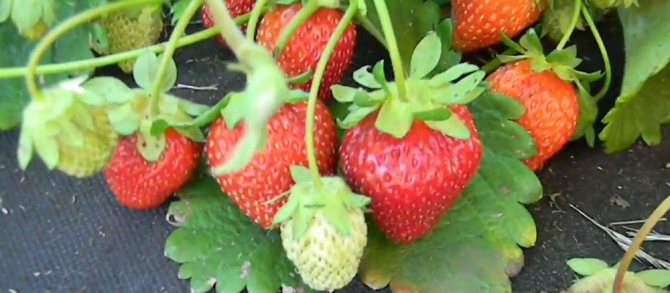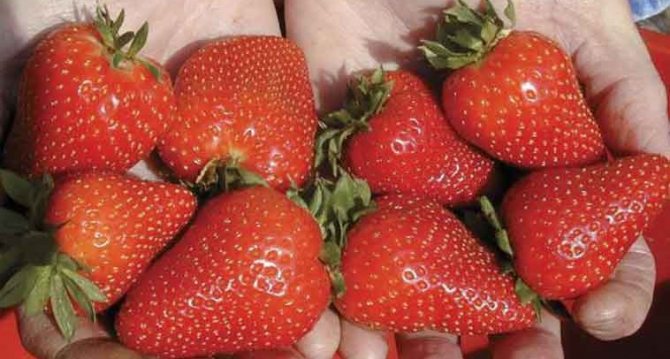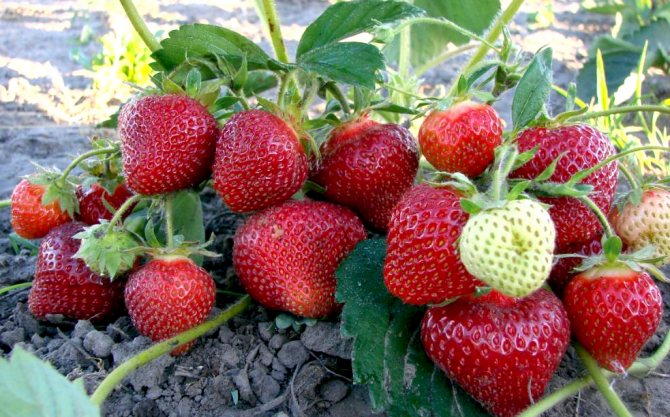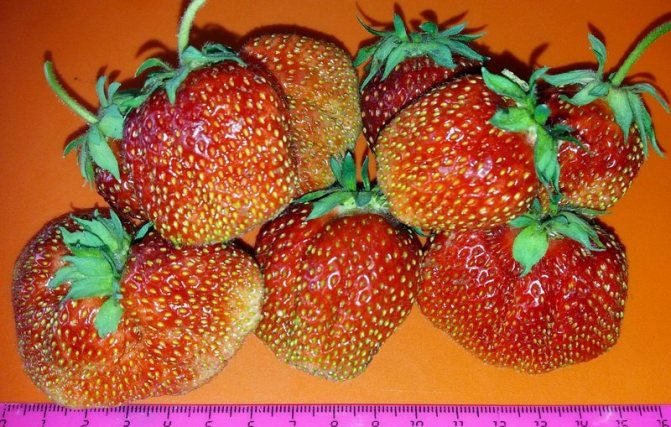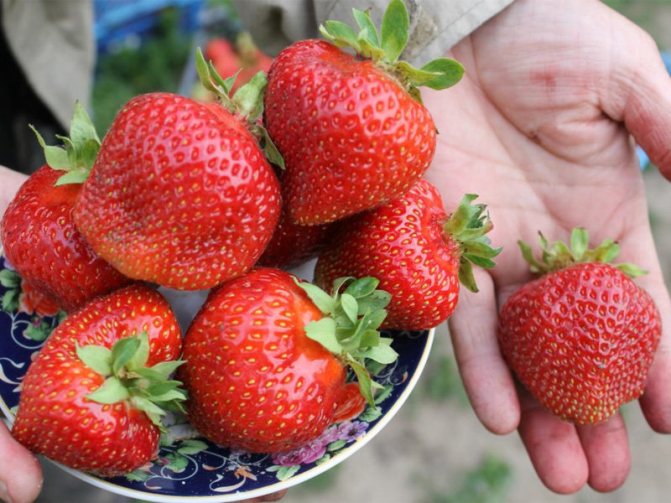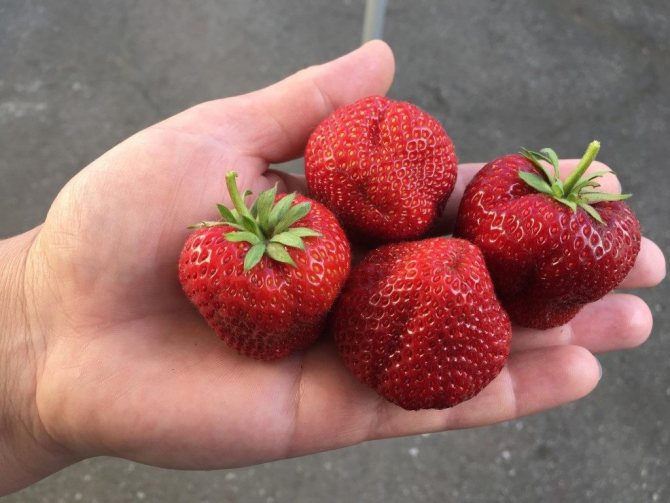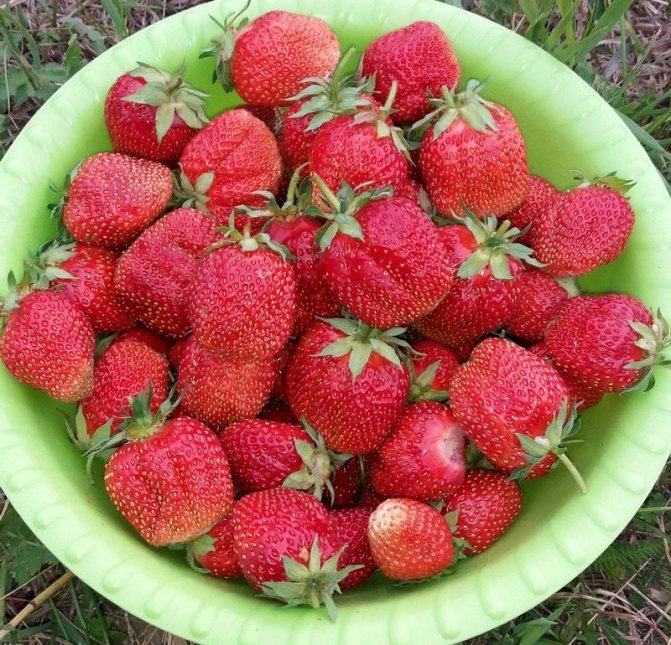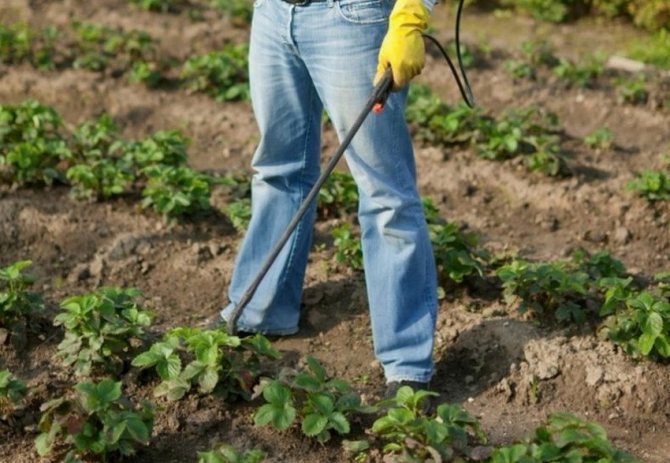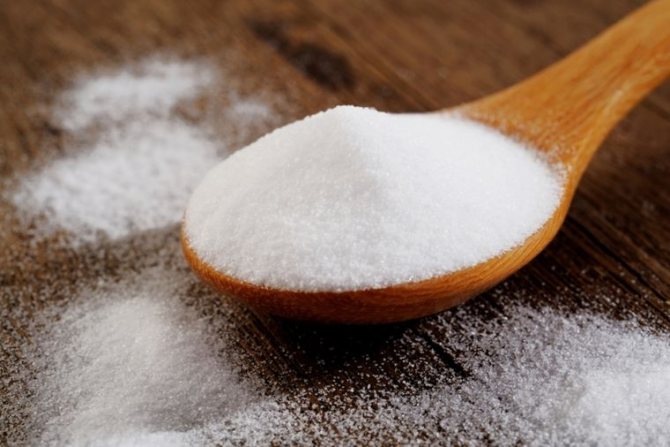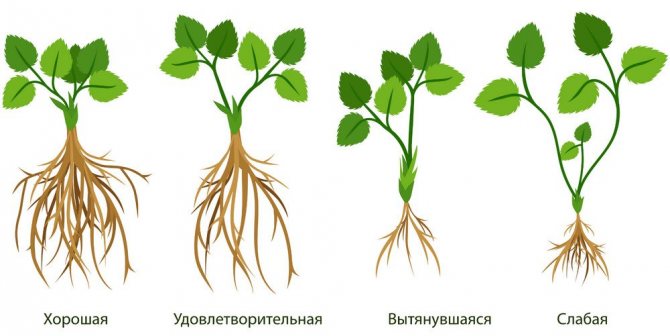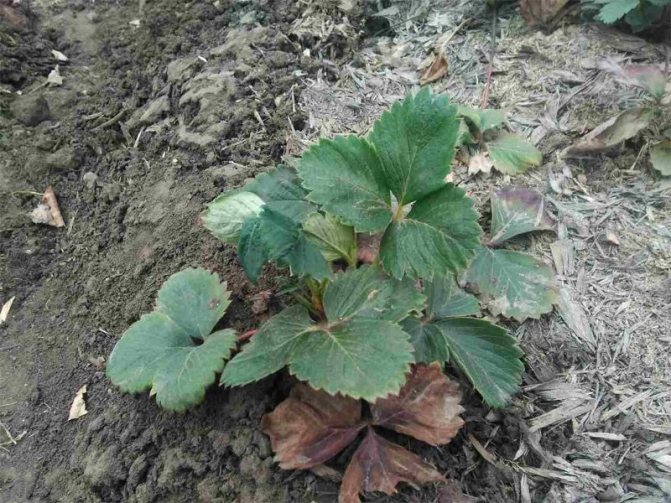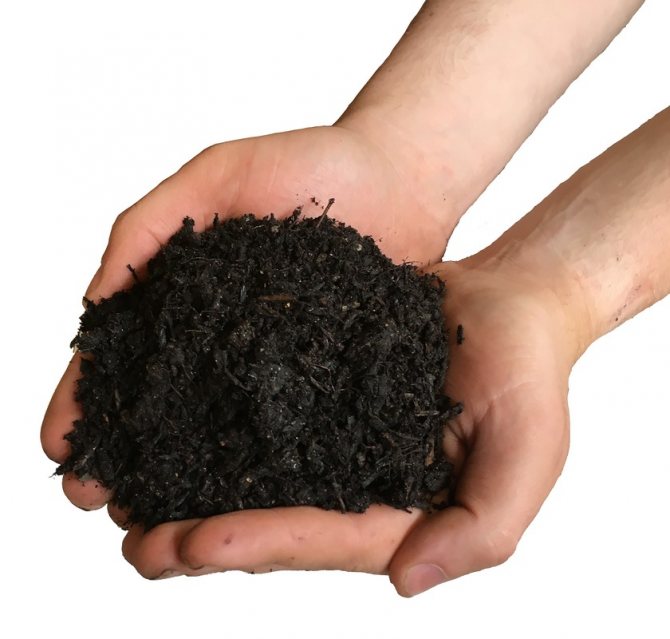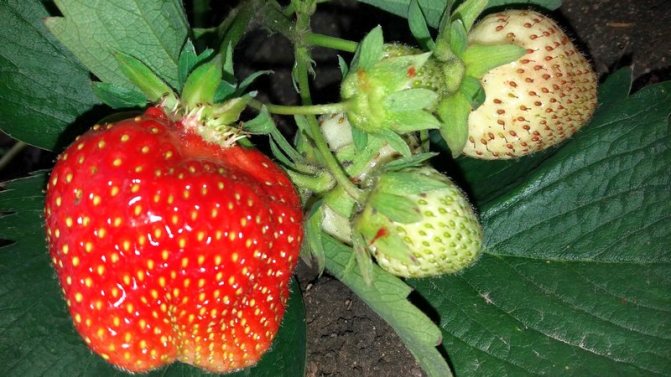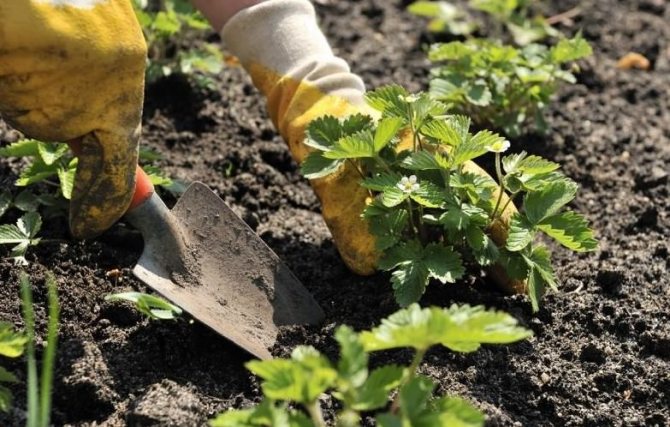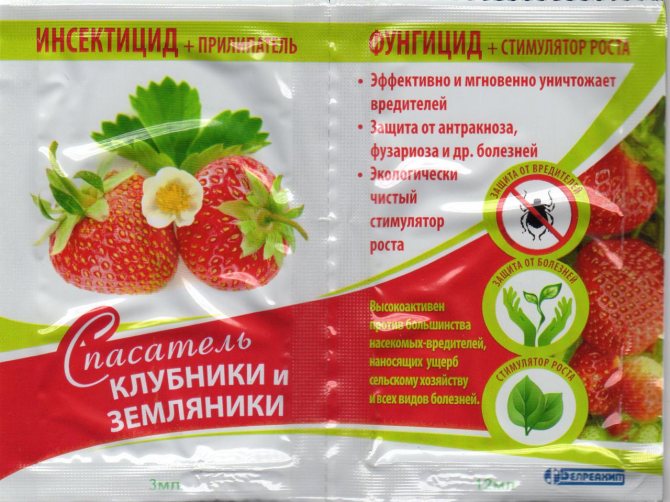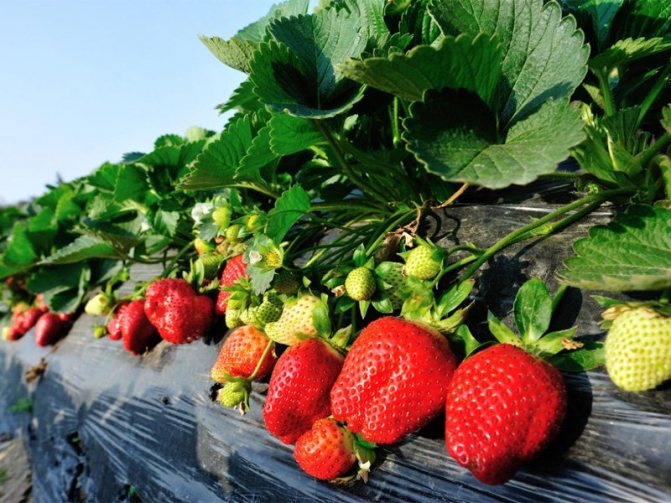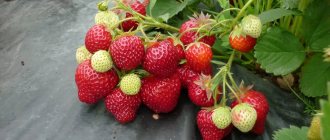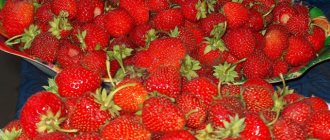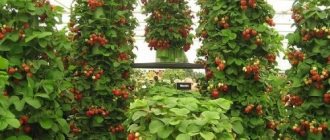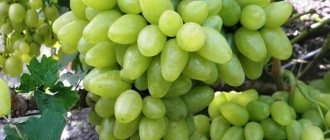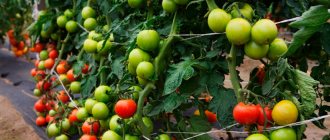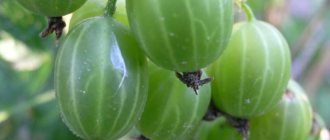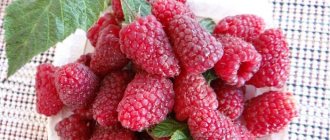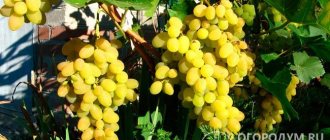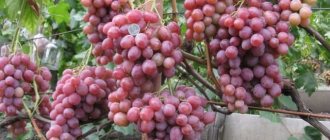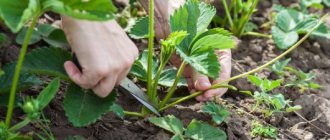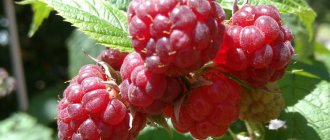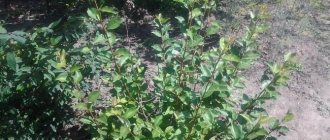Description of the variety
Photo:
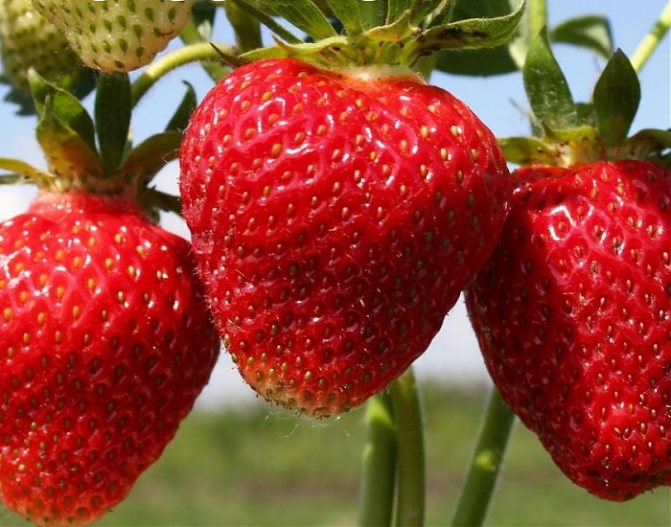
Festivalnaya strawberry is a non-repairable variety, but its fruiting is long. It is distinguished by large, powerful bushes, in the first year quite a lot of whiskers appear on them. In the future, the formation gradually decreases.
Strawberry leaves are dull green, wrinkled. The flowers are white with bright centers. They are bisexual, self-fertilized (self-fertile). The variety does not need additional pollination; plants can bear fruit in hotbeds, greenhouses. Inflorescences are compact, small.
The first berries appear in mid - late June, mass ripening is observed in July. Strawberries continue to bear fruit until early fall. The duration of the productive cycle is 3-4 years.
The description of the variety includes the characteristics of the berries:
- shape - oval, elongated;
- color - bright red;
- weight - up to 35 g (first berries), up to 10-15 g (fruits during the period of mass harvest);
- the skin is shiny;
- seeds - dark red, clearly visible on the surface of the berries;
- the pulp is tender, dense;
- taste - sweet and sour, unobtrusive.
Tasting assessment of taste is 4.4-4.5 points out of 5. This is a universal variety, fragrant berries are consumed fresh, canned, frozen. Strawberries retain their shape after thawing, heat treatment.
The fruits contain:
- sugar - 5.7-11.5%;
- acids - 1.1-1.8%;
- vitamin C - 73.5-85.3 mg (per 100 g).
The variety is the leader in the content of vitamin C. The composition also includes other useful substances.
a brief description of
Advantages of the variety
Festivalnaya strawberry is not in vain so beloved by gardeners. It has the following advantages:
- Unpretentiousness to the landing site. Can be planted both in the shade and in the sun. This advantage is actively used by gardeners with small plots, planting Festivalnaya between shrubs and trees, where there is free space.
- Easily multiplies by all known methods. Usov gives in sufficient quantity to renew the plantation every 3-4 years.
- The fruits are large, beautiful, bright. The taste is estimated by the tasters at 4.7 points. This is a great result. Festivalnaya is on top and is considered a classic of taste and aroma.
- The yield is high. Not every large-fruited variety can produce 180 c / ha.
- Long-term fruiting. Delicious berries can be enjoyed from the middle of the first month of summer until early September.
- With good shelter, it will withstand severe frosts in the Urals and Siberia.
- It is possible to grow on an industrial scale and harvest fruits using a mechanized method. Peduncles are compact and do not lodge.
- Strawberries behave well during heat treatment, do not break down into fibers.
The main disadvantage of the Festivalnaya variety is a strong root rot attack. The problem was solved through selection work, as a result of which the Relay variety was obtained. The relay is the result of crossing Festivalnaya with several resistant varieties, which took the best qualities from the parental form and at the same time practically does not suffer from soil infections.
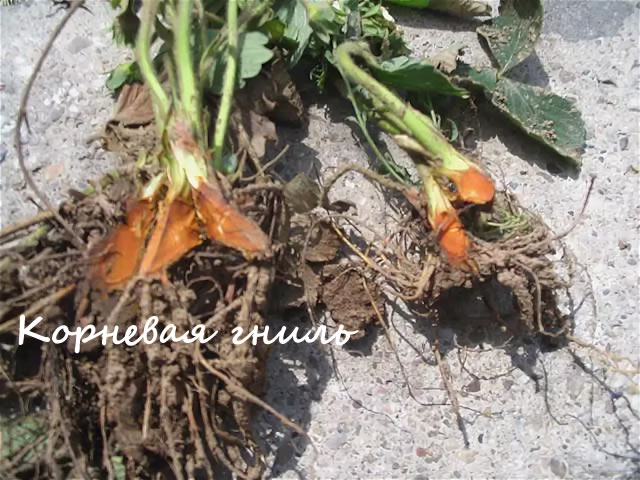

Disadvantages of the variety
- High demand for watering. If, when laying flower stalks, the plant lacks moisture, the yield will decrease, the berries will be smaller. A temporary drought will spoil two seasons at once.
- Despite the love for timely watering, prolonged waterlogging and lack of sunlight can lead to the development of powdery mildew and late blight.
- Bad for sale. The berries are large, but light. Keeping quality is low.
- Severely affected by root rot.
The joy of the Festival Strawberry is much more than a hassle. That is why this "old-timer" is so popular.
Productivity, collection, storage
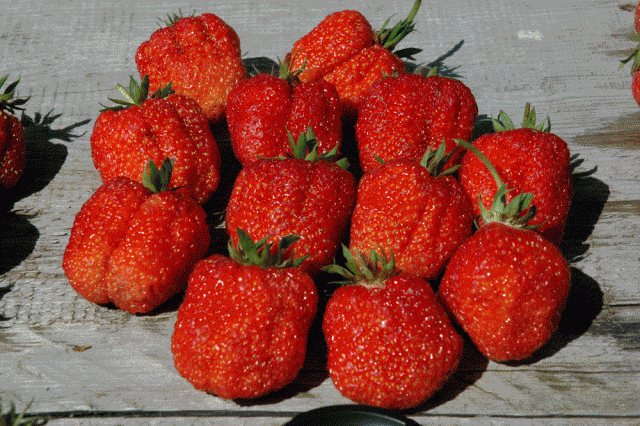

Festivalnaya strawberry has a high yield, up to 180 c / ha. From one bush, you can collect 0.2-0.7 kg (average 0.5 kg). Yields are based on open field strawberries.
Start picking berries as soon as they are completely reddened, but not yet soft. During the period of mass ripening of fruits, the collection should be carried out every other day, and in the heat - every day. It is better to pick berries in the morning or in the evening.
When picking, immediately sort the strawberries into large and small. Choose berries with defects, such fruits will be processed. It is better to pick strawberries with stalks, this will increase the shelf life. You can cut it off with sharp scissors. It is not recommended to take rotten, overripe fruits, which will then spoil the nearby strawberries.
Place the berries in wooden boxes, cardboard boxes, laying in 2-3 layers. It is undesirable to use other containers (buckets, packages): the strawberries are remembered, let the juice go. The harvested berries need to be processed as soon as possible.
Strawberries don't stay fresh for long:
- at room temperature - up to 8 hours;
- in the refrigerator - up to 5 days.
In the freezer, berries can be stored for up to 12 months. It is better to place fresh strawberries in the lower compartment of the refrigerator, where the temperature is created up to +2 ºС. Do not store the berries in plastic, they will quickly deteriorate, since air does not penetrate into such a container. It is recommended to put the strawberries in a cardboard box.
Before storing, sort the berries, separating the moldy ones. Otherwise, the mold will quickly cover the rest of the fruit. Strawberries should not be kept washed as they will deteriorate faster. Layers of berries can be transferred with paper towels. They will absorb excess moisture. Do not place too many layers of strawberries in the container.
Harvesting Festival
The most pleasant period for growing Festivalnaya comes in July. Pick ripe berries every 1–2 days, regardless of the weather. But for the market, transportation and storage (no more than 2 days in the refrigerator), only strawberries picked on a fine morning, when the dew has melted, and the berries have not yet warmed up in the sun, are suitable.
Festivalnaya is good frozen. The last small berries are dried and added to tea. The variety is suitable for the preparation of winter preparations: preserves, compotes, jam. The most useful and delicious delicacy in winter is fresh strawberries mashed with sugar. The mass is filled into plastic containers and stored in a freezer. Lovers of delicious alcohol prepare from the Festival liqueur, liqueurs, liqueurs.
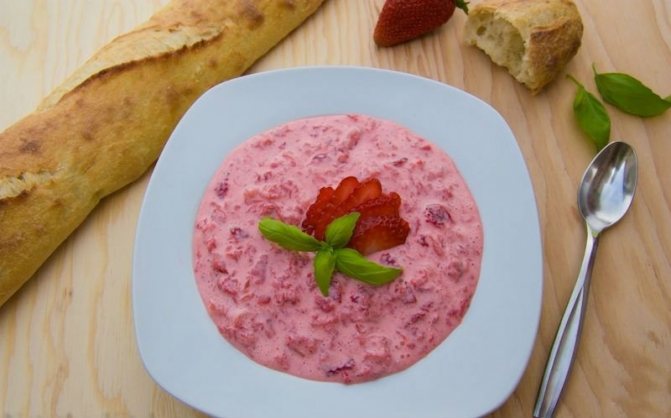

The famous dish - strawberries with cream - is not very beautiful, but unusually tasty
Suitable region and climate
The variety is unpretentious, gives high yields in unfavorable climates, on various soils. Festivalnaya strawberries are grown everywhere, the regions of the middle zone of the Russian Federation, the Urals, Siberia, and Belarus are better suited. Plants are resistant to cold, do not freeze in winter.
You can also grow strawberries in the southern regions, but due to too hot weather, yields will be less high. The fact is that the variety needs moisture and has a weak resistance to heat and drought. In such conditions, you will have to increase the number of waterings.
What are the pros and cons of the variety
The advantages of the Festival strawberry are that it:
- bears fruit amicably and for a long time;
- high-yielding;
- undemanding to growing conditions;
- resistant to gray mold, white spot;
- has tasty, juicy berries.
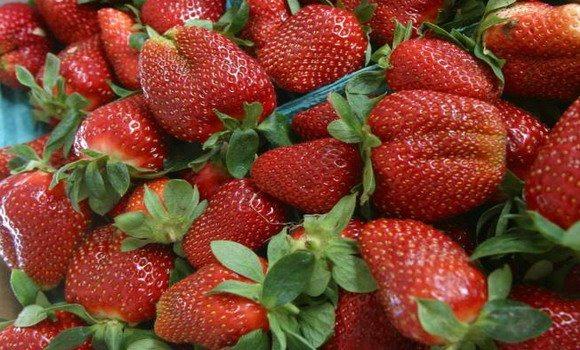

Among the minuses is only that the berries become small with improper care and as they grow in the same place. Often, strawberry bushes are damaged by a strawberry mite.
See also
Description and characteristics of the Eliane strawberry variety, cultivation and careRead
Breeding history
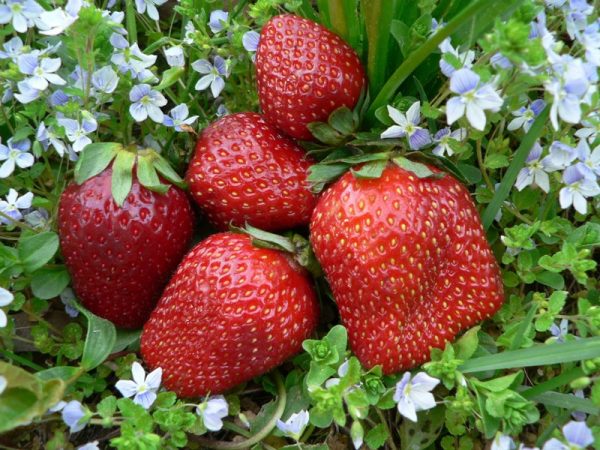

Strawberries were bred in 1954 at the VNIIR experimental station in the city of Pavlovsk (Leningrad region). The author is Yu. K. Katinskaya. Festivalnaya obtained by crossing the varieties Premier, Abundant. Over the next 4 years, measures were taken to improve the qualities.
The variety got its name in honor of the Festival of Youth and Students (1957). In 1958, strawberries entered the variety testing, they were added to the State Register of the Russian Federation in 1965. In 1973, Festivalnaya was included in the State Register of Belarus.
Reproduction
The Festivalnaya strawberry variety reproduces well with a mustache. Rosettes from healthy, productive bushes are rooted in nutritious pots. When two or three developed leaves appear, the seedlings are separated from the mother bush and planted in a permanent place.
Such methods of reproduction are also possible, such as dividing the bush and seeds. The latter method is used extremely rarely due to the length of the process. First, the seeds are soaked, then sown in boxes in a warm room, without burying the seeds. Ready seedlings are planted in the ground no earlier than the second half of May.


Testimonials
According to reviews, Festivalnaya strawberry is distinguished by its unpretentiousness, it tolerates cold winters and rainy summers well without losing productivity. Plants can be planted under trees.
Other advantages of the variety:
- Strawberries are frost-resistant up to 30 ° C. Damaged bushes are restored in the shortest possible time, without reducing the yield. Frosts in spring hardly harm the flowers.
- The variety gives high yields in the absence of additional pollination.
- Strawberries are delicious and aromatic. They are suitable for freezing, as they do not lose their shape after thawing.
- When harvesting, the fruits are almost not injured. The stem can be easily detached without damaging the strawberries.
- Unlike many other varieties, Festivalnaya can be transported.
Some people don't like the too firm flesh of a strawberry. Of the shortcomings, gardeners also note low disease resistance. Fruits are often affected by gray mold, powdery mildew. Strawberries can die due to verticillary wilting. If you don't take action, you can lose your entire crop.
Another disadvantage is susceptibility to pests (strawberry mite, nematode). The variety requires activities aimed at preventing lesions by fungal diseases, harmful insects. With proper care, the incidence decreases.
Many gardeners prefer to plant one of the large-fruited strawberry varieties called "Victoria". It has a high yield; in 1 season, up to 1 kg of berries can be harvested from a bush.
Victoria is resistant to frost, disease and pests. The fruits are very aromatic and tasty, the tasting score is up to 5 points. However, strawberries are difficult to transport, they wrinkle and spoil quickly.
Diseases and pests
This variety is very often faced with the following diseases and pests:
- Root rot. With this disease, black spots appear on the roots. The roots turn black, and after the roots the whole bush turns black, which, in the end, leads to its death. Black rot. With this disease, the berries become brown, their structure acquires a watery type.
- Late blight of roots. When a plant suffers from this disease, the roots turn orange, the bush turns yellow and becomes covered with brown spots.
- Gray rot. A dangerous disease that is a plague for the Festival.
- White / brown spotting. These diseases provoke the formation of white / brown spots on the leaves of the culture.
- Strawberry weevil. This parasite spends winter underground or under fallen leaves.During reproduction, the female lays eggs in the buds, offspring appears, which not only destroys the buds, but also sucks out all the juices from the leaves.
- Strawberry leaf beetle. This parasite feeds on the leaves of this culture.
- May beetle larvae. These pests damage the root system of the bush.
Growing
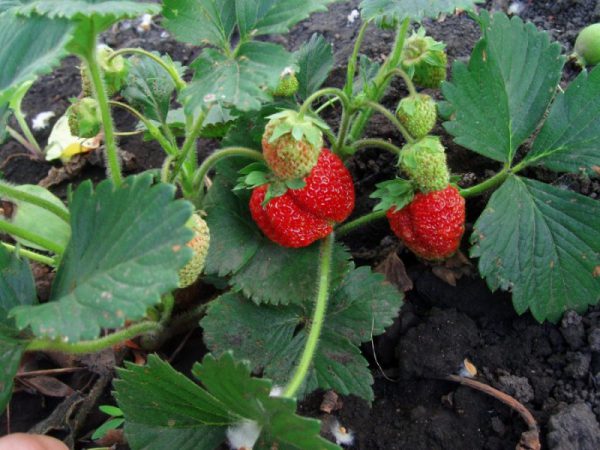

Suitable place, landing dates
Festivalnaya strawberry grows well on any soil, however, in order to increase the yield, plant a variety on sandy loam, loam with a slightly acidic reaction. It is better to choose a sunny place, sheltered from the wind. Groundwater should not be too high, the optimal level is below 80 cm.
Do not place strawberries after Compositae, buttercups, cucumbers, tomatoes, potatoes. Best predecessors:
- parsley;
- beet;
- dill;
- carrot;
- garlic;
- radish;
- legumes.
The culture is planted in spring (April-May), as well as in late summer - early autumn (the recommended period for the middle lane is from August 15 to September 20). You can plant garlic, onions, marigolds between the bushes, they will scare off pests, prevent the development of certain diseases.
Planting material
It is better to purchase planting material in the nursery. When choosing, pay attention to the condition of the roots. They must be well developed. Seedlings with weak roots may not take root.
Strawberries are propagated by separating the mustache with rosettes. A young shrub will be healthier if it is closer to the mother plant. Rosettes are taken from strawberries that have reached the age of 2-3 years and give a high yield.
It is not recommended to propagate plants by dividing the uterine bushes. It is better to root outlets in small containers, and then plant the bushes in a permanent place. Before planting, you can hold the roots in a solution of copper sulfate (30 g per 10 liters of water). This will strengthen the protection against fungal infections.
Site preparation
It is better to prepare a plot for strawberries in advance. If you plan to plant plants in the spring, treat the soil in the fall. For an autumn planting, prepare the ground at least 2 weeks in advance.
Dig the soil to a depth of 25 cm, picking out the roots of the weeds. At the same time add rotted manure, peat (5-6 kg / m2). Mineral dressings will also be required: superphosphate (50 g / m2), potash fertilizer (20 g / m2).
Landing
Make shallow holes according to the 30x30 cm pattern. They need to be shed well.
Landing order:
- Pinch the root of each seedling and cut off the leaves, leaving 3-4 pieces.
- Place the plant in the hole.
- Arrange the roots of the seedling evenly and carefully cover them with earth. At the same time, place the strawberries vertically, the root collar should be level with the soil.
- Compact the earth, water the seedlings well.
- Mulch the soil with rotted foliage, needles.
- If forecasters promise frosts, the bed can be additionally covered with a film or non-woven material.
To get a high yield, grow strawberries in one place for no longer than 4 years. It will be possible to plant the culture again in the same place after 2 years. During this time, the balance of nutrients in the soil will be restored.
Correct fit
In order for a culture to retain all its positive qualities, it is necessary not only to properly care for it, but also to plant it correctly. Festivalnaya is multiplied in several ways:
- Mustache.
- By dividing the bush.
- Seeds.
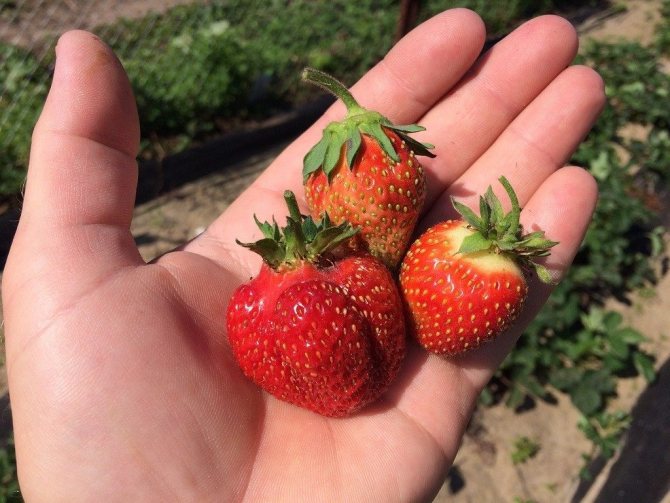

Experts recommend propagating the Festival with mustaches (rosettes). To do this, you need:
- Select uterine bushes. This procedure refers to the selection of bushes in the first year of planting. All mustaches are removed from the bushes.
- Notice these bushes are celebrated.
- Then, on all the bushes, you need to remove the buds in order to prevent them from blooming.
Since plants do not form berries, they will spend all their energy on the mustache. These mustaches will give the sockets. Small whiskers are removed, and large ones are left.
There are 2 ways to breed with a mustache:
- The first option is to dig the outlet to the ground, water and care for it like an ordinary bush, while not separating it from the mother.
- The second option is to transplant each outlet into a separate container with soil. This option is considered the most optimal. Then, after the new outlet has completely taken root, it is transplanted to a new place. It should be noted that 2 weeks before the transplant, you need to separate the mustache from the mother bush so that the new outlet learns to eat on its own.
Seasonal care
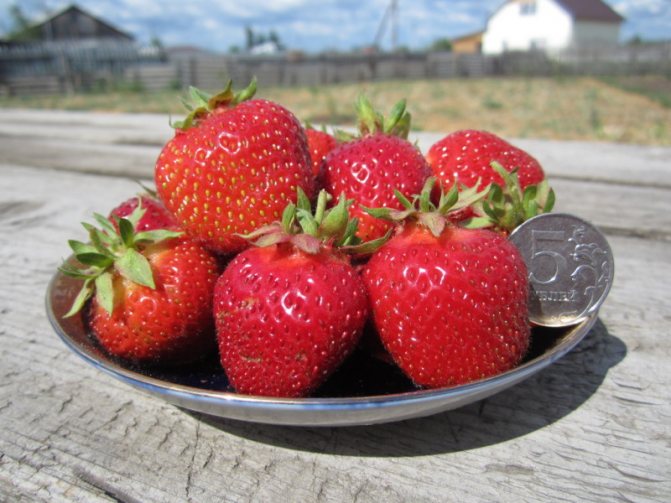

Spring
Start caring for strawberries by removing mulch, dried plants. Then carefully loosen the soil, being careful not to damage the roots. In some bushes, the growing point may be in the ground, then the soil needs to be slightly raked. If the roots of strawberries are bare, such bushes must be spud.
When the soil is dry, do water-charging. Subsequently water the strawberries once a week using warm water. To reduce moisture evaporation and prevent the appearance of weeds, mulch the beds with sawdust, straw, peat. The layer thickness should be 4-7 cm.
Top dressing is required: after the appearance of 2-3 leaves, before flowering and during the formation of ovaries. You can use urea (20 g per 10 liters of water). Add 500 ml of the prepared solution under each plant.
The following mixture gives a good result. Pour 300 g of manure with a bucket of water, after 2 days add 20 g of ammonium sulfate and spill the plants. You can fertilize strawberries with bird droppings (200 g per 10 l), the mixture should be infused for a day.
After feeding, pruning is necessary. Perform it with pruners, scissors, some parts can be cut off by hand. Examine the bushes, remove damaged, dry, diseased leaves by cutting them at a height of 5-7 cm.
If you are not planning to propagate strawberries, remove the mustache before flowering. Leave shoots 8-10 cm long. Do not allow the whiskers to root in the aisles. As a result, the plantings become denser, moreover, you can damage the roots of young strawberries during transplantation.
Be sure to weed the beds, otherwise the berries will be small and sour. 6-8 weeding is usually carried out per season. It is better not to touch strawberries during the harvesting period.
In the spring, treatment is needed to protect against insect pests and diseases. You can use "Fitosporin" (watering), "Zircon" (spraying). Against powdery mildew, gray rot, the bushes are sprayed with a 5% solution of potassium permanganate. For this purpose, iodine solution is also used (1/2 teaspoon per 10 liters of water).
Summer
In June, strawberries really need moisture; during this period, greens and berries grow on the bushes. In dry weather, plants are watered every 2 days or daily (to a depth of 30 cm). Do not pour water under the root, it is better to do this in the aisles. When the berries are harvested, moisten the soil once a week.
In summer, the mustache is also removed from the strawberries, the beds are loosened, weeded. Work the soil to a depth of 3-4 cm. Bushes of the second year need to be earthed, this stimulates root formation. Please note that it is not recommended to weed or loosen strawberries during fruiting.
After harvesting, treatment is carried out against diseases, harmful insects. Suitable preparation Fitoverm, copper sulfate. Recommended dosages are indicated in the instructions.
It is necessary to fertilize the plants with organic matter. Inspect strawberries regularly and remove damaged parts. After picking the berries, continue to loosen the plants (once every 2 weeks).
Fall
In the fall, you should loosen the garden, sprinkle strawberries, remove weeds. We need water charging irrigation. Water will protect the roots from freezing. Spill the earth to a depth of 30-50 cm.
In the autumn, organic matter is also introduced. Horse manure, mullein, humus must be spread out between the bushes. Mineral fertilizers are also required: superphosphate (35-40 g / m2), potassium salt (20-30 g / m2).
Spread the granules and cover them in the ground with a hoe, or prepare a slurry and spill the plants. Wood ash (150 g / m2) can replace mineral fertilizing.
Preparing for winter includes mulching. Cover the soil with plant material (needles, fallen leaves, straw). You do not need to cover the plants. Instead of mulch, you can pour a layer of earth 3-4 cm thick under the bushes and in the aisles.
Strawberry lovers' opinions
Some reviews of gardeners growing Festival strawberries:
Sergey, 56 years old, Barabinsk:
“Growing strawberries has been my hobby for decades. Festivalnaya garden strawberry was planted by me very first. Over the years working with strawberries, I have tried many varieties, but I am not going to give up the first beauty. My children ate festivals with pleasure, and now my grandchildren do not crawl out of the beds ”.
A source
Alexandra, 45 years old:
“The festival strawberry is truly unique. It grows in almost any soil. Of course, in order to obtain a high yield, it is worth choosing fertile soil or making regular fertilizing. For these purposes, I use rotted chicken manure. I put it into the ground before planting, as well as during the flowering of the bush. Thus, I manage to grow large and tasty berries. I water the strawberries during a drought in 2 days, and when the weather is cloudy, then once a week. "
A source
Varietal advantages and disadvantages
Problems in the incidence of this variety can be confirmed by only a few diseases, but such problems are extremely rare. The risk of morbidity can arise only if there is no care for it at all or the cultivation of a crop falls on unfavorable weather. Such problems will be solved if they are recognized in time (Figure 3).


Figure 3. The main advantage of the variety is its high yield
This fact, perhaps, is the only drawback of the Festivalnaya strawberry variety. But the hybrid has much more advantages.
These include:
- The fruiting period of strawberries stretches until late autumn, so several crops can be harvested from one garden bed for your own consumption and sale.
- High yield of the variety and excellent commercial quality of the fruit. However, it should be borne in mind that the largest berries are harvested in the first wave of the harvest. In the future, the berries begin to shrink.
- Simplicity and ease of care are combined with immunity to pests and a large number of crop diseases, resistance to drought and frost.
- Bushes can be planted not only in the sun, but also in light shade. This arrangement will absolutely not affect the appearance and taste of the berries.
Russian gardeners had enough time to test the variety. Compatriots often speak positively about the Festival variety of strawberries, which means it deserves it.


